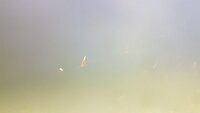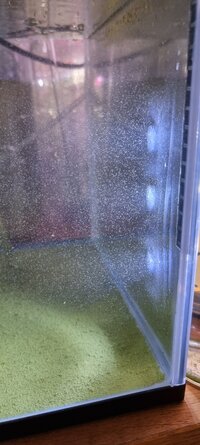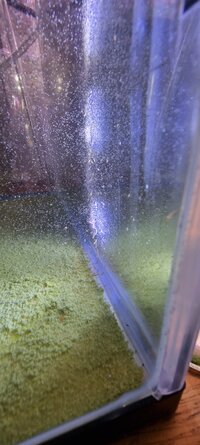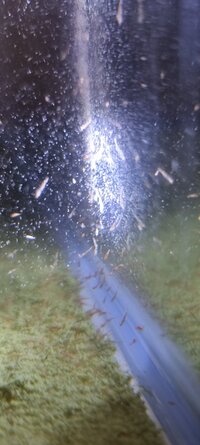-
You are viewing the forum as a Guest, please login (you can use your Facebook, Twitter, Google or Microsoft account to login) or register using this link: Log in or Sign Up
You are using an out of date browser. It may not display this or other websites correctly.
You should upgrade or use an alternative browser.
You should upgrade or use an alternative browser.
Amano Shrimp breeding project
- Thread starter Animek87
- Start date
Hey guys
day 35
lots of zoe's died i think there's about 60+ left not sure as water parameters didn't changed, first newborn zoe's added to salt water tank i think those few (about 10) hatched from eggs dropped by other females.
From 8 berried females 3 left with lots of eggs and they should start releasing them from 28th
day 35
lots of zoe's died i think there's about 60+ left not sure as water parameters didn't changed, first newborn zoe's added to salt water tank i think those few (about 10) hatched from eggs dropped by other females.
From 8 berried females 3 left with lots of eggs and they should start releasing them from 28th
I met a marine biologist once who successfully bred them in their lab. They said it was easy, the main two points being
1/ having a large tank (500l) with just salt water and using water from that for water changes. (The shrimp themselves were in smaller tanks.)
2/ having multiple stable phytoplankton cultures to feed them with.
They might have had multiple large tanks at different salinities, it was a few years ago so I can't remember all the details.
I do remember asking if it was hard keeping the cultures alive and she laughed and said it's not hard ordering more
1/ having a large tank (500l) with just salt water and using water from that for water changes. (The shrimp themselves were in smaller tanks.)
2/ having multiple stable phytoplankton cultures to feed them with.
They might have had multiple large tanks at different salinities, it was a few years ago so I can't remember all the details.
I do remember asking if it was hard keeping the cultures alive and she laughed and said it's not hard ordering more
Hi all
today is day 41 and first Zoe morphed into amano shrimp 😉
I've catched it and now trying to acclimatise for fresh water
Shrimp transferred to glass with Zoe tank water and filling rest of the glass untill full with fresh water, I will repeat that until salanity is 0
today is day 41 and first Zoe morphed into amano shrimp 😉
I've catched it and now trying to acclimatise for fresh water
Shrimp transferred to glass with Zoe tank water and filling rest of the glass untill full with fresh water, I will repeat that until salanity is 0
Attachments
today is day 41 and first Zoe morphed into amano shrimp 😉
 Congrats.
Congrats.sparkyweasel
Member
- Joined
- 30 Jun 2011
- Messages
- 2,984
Yes, congrats indeed. I understand this is a rare achievement 🙂
Hey Guys
today is day 46
by now 4 zoe's morphed 1 gone missing (can't see it in 12l tank) dead or hiding
3 morphed yesterday 2 in the afternoon and 1 in the evening, last one died due to my mistake
first 2 were acclimatising by 1 drop of fresh water every 20-30s slowly decreasing salanity where the last one was moved from 34ppm salanity to 7ppm so on this part you need to be extremely careful and do it slowly with patience
I'll update this post with final results in 2 weeks
Many thanks for everyone's support and hopefully this will help with other people amano projects in future
Cheers
today is day 46
by now 4 zoe's morphed 1 gone missing (can't see it in 12l tank) dead or hiding
3 morphed yesterday 2 in the afternoon and 1 in the evening, last one died due to my mistake
first 2 were acclimatising by 1 drop of fresh water every 20-30s slowly decreasing salanity where the last one was moved from 34ppm salanity to 7ppm so on this part you need to be extremely careful and do it slowly with patience
I'll update this post with final results in 2 weeks
Many thanks for everyone's support and hopefully this will help with other people amano projects in future
Cheers
Last edited:
DutchMuch
Member
this is awesome.
I'll update this post with final results in 2 weeks
And what happened with the update? 🙄
three-fingers
Member
Raising Amano zoes is hard, I've tried and failed miserably before, lets hope they just never had the opportunity to and then forgot to post, but the documentation and effort here is commendable even if they all died!
I think by now there is plenty of information on the internet for breeding Caridina Multidentata. In fact many have failed and then have succeeded by improving the process.
It's just an involved process and even more so if not planned. Once you are prepared then it isn't that hard I think. I have even seen breeding these shrimps in mere 5 gallon plastic buckets with success. Thing is that many times people just want to rush and breed them once they see the female berried. Unfortunately that is too late and chances are it will be very very difficult simply because of the amount of times you need to feed these creatures per day and the pollution generated, water changes.... For breeding these shrimps one needs to plan properly in advance specially the breeding tank. The breeding tank needs to be set up one if not two or three weeks prior hatching. This is so that the water is loaded with phytoplankton. This allows little to no interference from human once zoes are placed in the saline water tank. Also what I have noticed is that most experiments I have seen around don't really mention anything about the importance of the phytoplankton used. What I mean by that is that each phytoplankton specie has a different cell size and not all are suitable at all stages of the development of the zoes. That is something I have noticed has never been mentioned in any of the experiments I have read and I think I have read most if not all the available ones on internet including those in this forum. The ones that seem to have had the most success are those who planned in advance and made a proper phytoplankton soup. By most success I mean a high survival rate.
I think the phytoplankton selection and the preparation are the most critical aspects of breeding these shrimps. For salinity, most people seem to agree that brackish is a no go despite what that old Japanese research paper says. Water needs to be fully saline water.
I will in due time carry out my own experiment, the el cheapo way (as a proof of concept) and will report my findings. I am feeling rather confident that with the amount of information already available it shouldn't be much of an issue. Problem is most people don't bother breeding the Caridina Multidentata for business simply because it's not cost effective. It's cheaper caught from the wild. If you have access to free clean sea water then things could be cost effective.
It's just an involved process and even more so if not planned. Once you are prepared then it isn't that hard I think. I have even seen breeding these shrimps in mere 5 gallon plastic buckets with success. Thing is that many times people just want to rush and breed them once they see the female berried. Unfortunately that is too late and chances are it will be very very difficult simply because of the amount of times you need to feed these creatures per day and the pollution generated, water changes.... For breeding these shrimps one needs to plan properly in advance specially the breeding tank. The breeding tank needs to be set up one if not two or three weeks prior hatching. This is so that the water is loaded with phytoplankton. This allows little to no interference from human once zoes are placed in the saline water tank. Also what I have noticed is that most experiments I have seen around don't really mention anything about the importance of the phytoplankton used. What I mean by that is that each phytoplankton specie has a different cell size and not all are suitable at all stages of the development of the zoes. That is something I have noticed has never been mentioned in any of the experiments I have read and I think I have read most if not all the available ones on internet including those in this forum. The ones that seem to have had the most success are those who planned in advance and made a proper phytoplankton soup. By most success I mean a high survival rate.
I think the phytoplankton selection and the preparation are the most critical aspects of breeding these shrimps. For salinity, most people seem to agree that brackish is a no go despite what that old Japanese research paper says. Water needs to be fully saline water.
I will in due time carry out my own experiment, the el cheapo way (as a proof of concept) and will report my findings. I am feeling rather confident that with the amount of information already available it shouldn't be much of an issue. Problem is most people don't bother breeding the Caridina Multidentata for business simply because it's not cost effective. It's cheaper caught from the wild. If you have access to free clean sea water then things could be cost effective.
Hi Everyone
I've decided to refresh my old journal as recently I've started breeding amano on regular basis.
Apologies I didn't update you with final results
I think it was mabye 10 zoes which morphed and mabye 3 out of those survived in fresh water
Later on i tyred to repeat my "success" and failed miserably =/ all of them died after few days
In past few months I've decided to prepare myself better and I think I have now good knowledge to have successful breeding setup
Current setup is close to what it was before with small adjustments
Let's start with my breeding group
I've purchased 10 adults (2 different shops ) turns out i have 7 females and 3 males
Setup
11l tank for zoes no heater only 3v mini lamp
water temp ( room) 18-23 degrees Celsius
salinity 32-35ppm
air pump (few bubbles /s)
Feed
phytoplankton
I'm using Nannochloropsis sp which gives me great results
Rotifers - live culture
Process
When I first notice berried female i write down date after apx 4 weeks + i force them to drop eggs by removing them from main tank to 2l jar with air stone (quite strong current) next day they will start releasing zoe's for about week and all dropped eggs will start hatching.
Fishing zoe's by attracting them to the light
Every female without eggs is transferred back to the main tank.
Few times a day all zoe's are transferred to zoe's tank with pipette, from first day i start feeding them (5-10ml of phyto even to get water cloudy )
after 2 weeks I introduce rotifers, they will make water completley transparent after week and zoe's will feed on them (you can still dose phyto in order to keep rotifers multiplying)
First zoe's should morph after 4 weeks
when I notice morphed Zoe I take it out and put in temporary jar with same salinity water.
Freshly morphed zoe's are bit orange or have orange line which can be easily spotted,
i wait another 3-4 days before transferring them to fresh water as they must be transparent with no orange in their body otherwise they will die.
Transfer method 1
few times when babies were completley transparent I've just chucked them in fresh water and they were ok
now I prefer safer method on which I have more control
Transfer method 2
1-2l jar I fill with 100ml of "zoe's water" then I do drip acclimatisation with water from main tank ( 1 drop every 2-3s) so it takes apx 5-12h
every now and then I check salinity and if all babies are alive.
If after few h you can see orange in transferred babies put them back onto full salinity water as from my experience they won't survive ( they will need 1-2 more days before transferring)
my notes below
eggs 27/06/2022 *2
release 01/08
eggs 02/07/2022
release 06/08
eggs 07/07/22
release 11/08
first Zoe 25/07
new hatched zoes 29/07 until 03/08
29/08 - first morphed
totals :
morphed - 29
dead - 15
alive - 14 in main tank
___________________________
06/08/22 - eggs
31/08/22 07/09 - first Zoe transfer
27/09/22 - 9 morphed 1 dead
27/09/22 - 4 temporary jar
01/10/22 - change jar 0
01/10/22 - 4 main tank
totals :
morphed -
dead -
alive -
___________________________
from above you can see its my second run and it looks promising
When preparing to breed amano again I've watched a lot of Avatar Aquatics videos


above 1 baby rdy to transfer and 2 still orange
Ps. I'm planning to breed bamboo shrimps and if successful I'll start new journal
I've decided to refresh my old journal as recently I've started breeding amano on regular basis.
Apologies I didn't update you with final results
I think it was mabye 10 zoes which morphed and mabye 3 out of those survived in fresh water
Later on i tyred to repeat my "success" and failed miserably =/ all of them died after few days
In past few months I've decided to prepare myself better and I think I have now good knowledge to have successful breeding setup
Current setup is close to what it was before with small adjustments
Let's start with my breeding group
I've purchased 10 adults (2 different shops ) turns out i have 7 females and 3 males
Setup
11l tank for zoes no heater only 3v mini lamp
water temp ( room) 18-23 degrees Celsius
salinity 32-35ppm
air pump (few bubbles /s)
Feed
phytoplankton
I'm using Nannochloropsis sp which gives me great results
Rotifers - live culture
Process
When I first notice berried female i write down date after apx 4 weeks + i force them to drop eggs by removing them from main tank to 2l jar with air stone (quite strong current) next day they will start releasing zoe's for about week and all dropped eggs will start hatching.
Fishing zoe's by attracting them to the light
Every female without eggs is transferred back to the main tank.
Few times a day all zoe's are transferred to zoe's tank with pipette, from first day i start feeding them (5-10ml of phyto even to get water cloudy )
after 2 weeks I introduce rotifers, they will make water completley transparent after week and zoe's will feed on them (you can still dose phyto in order to keep rotifers multiplying)
First zoe's should morph after 4 weeks
when I notice morphed Zoe I take it out and put in temporary jar with same salinity water.
Freshly morphed zoe's are bit orange or have orange line which can be easily spotted,
i wait another 3-4 days before transferring them to fresh water as they must be transparent with no orange in their body otherwise they will die.
Transfer method 1
few times when babies were completley transparent I've just chucked them in fresh water and they were ok
now I prefer safer method on which I have more control
Transfer method 2
1-2l jar I fill with 100ml of "zoe's water" then I do drip acclimatisation with water from main tank ( 1 drop every 2-3s) so it takes apx 5-12h
every now and then I check salinity and if all babies are alive.
If after few h you can see orange in transferred babies put them back onto full salinity water as from my experience they won't survive ( they will need 1-2 more days before transferring)
my notes below
eggs 27/06/2022 *2
release 01/08
eggs 02/07/2022
release 06/08
eggs 07/07/22
release 11/08
first Zoe 25/07
new hatched zoes 29/07 until 03/08
29/08 - first morphed
totals :
morphed - 29
dead - 15
alive - 14 in main tank
___________________________
06/08/22 - eggs
31/08/22 07/09 - first Zoe transfer
27/09/22 - 9 morphed 1 dead
27/09/22 - 4 temporary jar
01/10/22 - change jar 0
01/10/22 - 4 main tank
totals :
morphed -
dead -
alive -
___________________________
from above you can see its my second run and it looks promising
When preparing to breed amano again I've watched a lot of Avatar Aquatics videos


above 1 baby rdy to transfer and 2 still orange
Ps. I'm planning to breed bamboo shrimps and if successful I'll start new journal
Last edited:
I've been messing around breeding these, so I will share my experience here. I found that leaving them alone to do their thing works the best. I tried heaters, water changes, frequent feeding, turning down bubbler etc. - I would end up with a few per batch - I learned those were all mistakes.
I only try in the summer - I found out the warmer the better. They won't morph for many weeks when kept in low temperatures, they all seem to slow down during winter and you don't have to bother with heaters etc.
I prep the salt water tank around 1-2 weeks prior. I add salt as per instruction on the label. I keep some cheap light above the tank 24/7 for first two weeks and small sponge filter. Then I dose few ml of the green water every few days. Bubbler runs quite high - I go with the logic: if they survive in the open sea they will survive the sponge filter - more oxygen is better. Usually algae/filth appears after two weeks - that is food - if I see plenty of it, I turn the light down to 12h and stop feeding all together.
Best yields (50+) I achieved when growing them out in full green water. It just kind of happens eventually during first two weeks. Only takes a little amount of green water to get it going, I get it from ebay for couple of quid.
I put the berried female in the grow out cube and once she drops, I catch the babies after dark using my phone torch. I then drop them into salt water straight away. That's it.
I leave them be and just top up the water as it evaporates. No feeding, no water changes. Just let them do their thing.
There is a massive die off within first 1-2 days after moving them in the salt water - That's when I lose most of them (probably 75%+) . No matter what I try - I cannot avoid that - I can only guess that is what happens in nature too ?
Anyway everything that survives that first die off, will likely get to the end fine. Any casualties are most likely my fault from here...
In high temperatures (24-25), it takes them 4-5 weeks to morph, Once I start seeing some of them morphed, I try and catch as many as I can - they usually just chill on the glass - then I give the rest another week and then drain the whole thing -It's easier to catch them that way. I drip adjust them to fresh water - usually couple of hours is enough - the slower the better here.
After that, they do not really die and are quite hardy little things - I once accidentally left one little guy in a drop of water overnight at the bottom of a jug with my net and all the other tools... it survived fine.
Some pictures below.


I only try in the summer - I found out the warmer the better. They won't morph for many weeks when kept in low temperatures, they all seem to slow down during winter and you don't have to bother with heaters etc.
I prep the salt water tank around 1-2 weeks prior. I add salt as per instruction on the label. I keep some cheap light above the tank 24/7 for first two weeks and small sponge filter. Then I dose few ml of the green water every few days. Bubbler runs quite high - I go with the logic: if they survive in the open sea they will survive the sponge filter - more oxygen is better. Usually algae/filth appears after two weeks - that is food - if I see plenty of it, I turn the light down to 12h and stop feeding all together.
Best yields (50+) I achieved when growing them out in full green water. It just kind of happens eventually during first two weeks. Only takes a little amount of green water to get it going, I get it from ebay for couple of quid.
I put the berried female in the grow out cube and once she drops, I catch the babies after dark using my phone torch. I then drop them into salt water straight away. That's it.
I leave them be and just top up the water as it evaporates. No feeding, no water changes. Just let them do their thing.
There is a massive die off within first 1-2 days after moving them in the salt water - That's when I lose most of them (probably 75%+) . No matter what I try - I cannot avoid that - I can only guess that is what happens in nature too ?
Anyway everything that survives that first die off, will likely get to the end fine. Any casualties are most likely my fault from here...
In high temperatures (24-25), it takes them 4-5 weeks to morph, Once I start seeing some of them morphed, I try and catch as many as I can - they usually just chill on the glass - then I give the rest another week and then drain the whole thing -It's easier to catch them that way. I drip adjust them to fresh water - usually couple of hours is enough - the slower the better here.
After that, they do not really die and are quite hardy little things - I once accidentally left one little guy in a drop of water overnight at the bottom of a jug with my net and all the other tools... it survived fine.
Some pictures below.


Good job placente once i did green water bit all of them died, with second attempt i introduced rotifers by accident so they ate all phyto
Attachments
Not so sure. When you create green water, you use RO or dechlorinated tap water right? You then add salt and light the tank. Unless you purposefully add some specific algae I think the algae spores are already present in the water and will develop with the light. Obviously you will have some algae sp that have more or less affinities with sodium but in our context I think they are the same.if so then different type of algae you have there
Anyhow, I am aware that zoe need salty waters. The idea was merely to use that green water to inoculate the zoe tank with algae. I will make some test and prepare a solution of that green water and mix salt to 35ppm in a small container to see if the algae survives.
Last edited:









